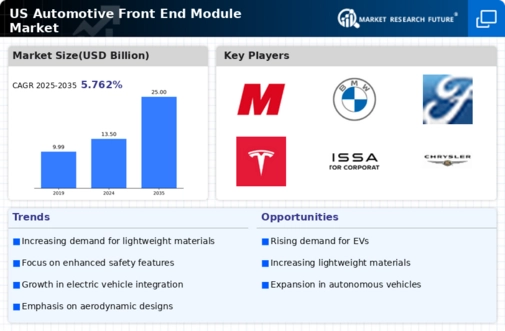Rising Demand for Fuel Efficiency
The automotive front-end-module market experiences a notable surge in demand driven by the increasing consumer preference for fuel-efficient vehicles. As fuel prices fluctuate, consumers are more inclined to purchase vehicles that offer better mileage. This trend compels manufacturers to innovate and integrate lightweight materials and aerodynamic designs into front-end modules, enhancing overall vehicle efficiency. In 2025, the automotive sector in the US anticipates a growth rate of approximately 4.5% in fuel-efficient vehicle sales, which directly influences the automotive front-end-module market. The emphasis on reducing vehicle weight and improving fuel economy is likely to propel advancements in front-end module designs, making them more competitive in the market.
Growth of Electric Vehicle Segment
The The market is poised for growth. due to the rapid expansion of the electric vehicle (EV) segment. As more consumers opt for electric vehicles, manufacturers are adapting their front-end module designs to accommodate the unique requirements of EVs, such as battery placement and cooling systems. The US electric vehicle market is projected to grow at a compound annual growth rate (CAGR) of 20% through 2025, which will likely have a direct impact on the automotive front-end-module market. This shift towards electrification necessitates innovative designs and materials that can support the performance and efficiency of electric vehicles, thereby driving demand for advanced front-end modules.
Consumer Preference for Enhanced Aesthetics
Consumer preferences are shifting towards vehicles that not only perform well but also exhibit superior aesthetics. The automotive front-end-module market is responding to this trend by focusing on design elements that enhance the visual appeal of vehicles. As consumers increasingly prioritize style alongside functionality, manufacturers are investing in advanced design techniques and materials that allow for more attractive front-end modules. In 2025, it is estimated that the market for aesthetically pleasing vehicle designs will grow by approximately 5%, further stimulating the automotive front-end-module market. This emphasis on aesthetics is likely to drive innovation and competition among manufacturers, leading to a diverse range of front-end module designs.
Regulatory Pressure for Emission Reductions
The The market is significantly influenced by regulatory pressures. aimed at reducing vehicle emissions. In the US, stringent regulations imposed by the Environmental Protection Agency (EPA) require manufacturers to lower carbon emissions from vehicles. This regulatory environment encourages the development of lighter and more efficient front-end modules that contribute to overall vehicle performance and compliance with emission standards. As of 2025, the automotive industry is expected to invest over $10 billion in technologies that support emission reductions, which will likely enhance the demand for innovative front-end modules. Consequently, manufacturers are compelled to adapt their designs to meet these evolving regulations, thereby driving growth in the automotive front-end-module market.
Technological Advancements in Automotive Design
Technological advancements play a pivotal role in shaping the automotive front-end-module market. The integration of cutting-edge technologies such as 3D printing and computer-aided design (CAD) allows manufacturers to create more complex and efficient front-end modules. These innovations not only enhance the aesthetic appeal of vehicles but also improve functionality and safety. In 2025, the market is projected to witness a growth of around 6% due to the adoption of these technologies. As manufacturers strive to meet consumer expectations for modern design and performance, the automotive front-end-module market is likely to benefit from these technological shifts, leading to more sophisticated and efficient products.



















Leave a Comment